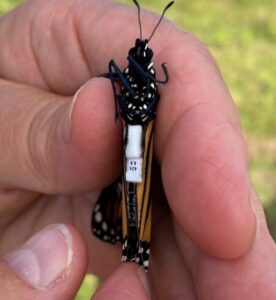(Story and photos by Diane De Luca)
Monarch Tagging
The placement of tiny Nanotags on migrating monarch butterflies is part of the larger Motus Project, a global migration tracking system that NH Audubon and many partners are expanding in the Northeast. Nanotags are lightweight radio-transmitters with unique signals that can be detected by Motus receivers placed throughout the landscape. These nanotags will, hopefully, allow biologists to track fall movements of monarch butterflies. The last summer generation of monarchs travel south to overwinter in central Mexico. A journey of close to 3000 miles. Tracking information can help to identify target areas for conservation or habitat improvement, such as planting fall-blooming nectar sources to support migrating monarchs.
The monarch is a formerly abundant butterfly species that has experienced dramatic and widespread declines since the early 1990’s. Conservation efforts are underway across the US to understand and take action to stop this decline. Biologists have used adhesive paper tags to study monarch migration since the 1940’s. Tagging in this way has yielded some information about migration routes, but the majority of the tags are recovered at the wintering areas in Mexico. The Motus tracking system, however, makes it possible to determine travel speeds and trajectories during the course of migration. Increased understanding of post-emergence behavior and migration travel of monarchs can help to inform conservation efforts.
2023 Tagging
In 2023, New Hampshire Audubon placed 50 nanotags on monarchs migrating along the coast and through the Great Bay National Wildlife Refuge and inland through Concord. The 50 nanotags that were deployed this year will build on the knowledge gained from 59 nanotags that were deployed on monarchs in 2022.

Where and when our tagged monarchs are picked up by a Motus tower will help to further our learning about monarch migration. We are excited to share that to date, 15 of our tagged monarchs have been picked up by towers as they continued their migration. All tell a story that we can use to inform our knowledge of migration and potential conservation efforts.
Although the data is still preliminary, we are comfortable that the 15 tagged monarchs that have been detected by towers after release are highly likely to be true detections. 11 of 27 tagged monarchs that were released at the Great Bay National Wildlife Refuge have been detected at other Motus towers. Four of the 23 tagged monarchs released at the McLane Center in Concord have also had returns from other towers. This represents a 30% return rate overall, with a 41% detection rate from the coastal migrants. Wow! More than that, the flight patterns and distances are truly impressive.

Distance
The distances traveled by our tagged monarchs are truly impressive, and we know this is only part of the journey. Three of the monarchs that left Great Bay were detected by a tower in the Blackwater National Wildlife Refuge in Maryland. All flew an average of 40 miles per day to arrive at this site in early October. In the last couple of days, we had an additional detection on a high point in the Blue Ridge Mountains – a minimum distance of 520 miles.
Locations
Along with the impressive flights, the 2023 returns are giving us a glimpse into the importance of location. We were blown away to see our 2023 tagged monarchs following some of the same routes as the 2022 cohort. As last year, a migrating monarch flew south to be picked up by both the Lynnfield, MA and Pomfret, CT towers. This same monarch continued on to Blackwater. This is truly eye opening and has the power to help define monarch conservation.
This second year of tagging has continued to enhance our learning. Stay tuned for more details in the upcoming Afield.
